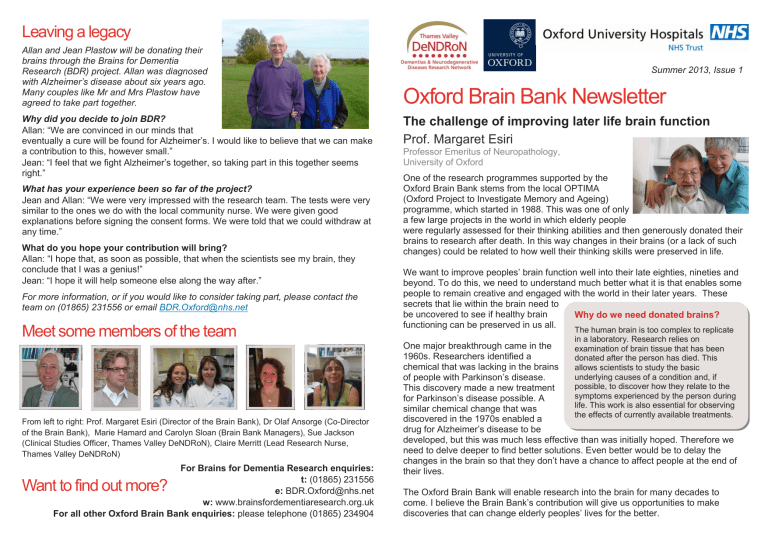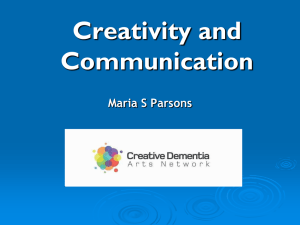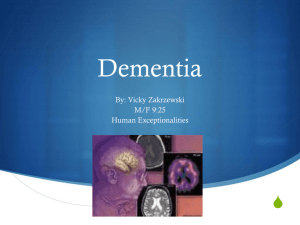Leaving a legacy

Leaving a legacy
Allan and Jean Plastow will be donating their brains through the Brains for Dementia
Research (BDR) project. Allan was diagnosed with Alzheimer’s disease about six years ago.
Many couples like Mr and Mrs Plastow have agreed to take part together.
Why did you decide to join BDR?
Allan: “We are convinced in our minds that eventually a cure will be found for Alzheimer’s. I would like to believe that we can make a contribution to this, however small.”
Jean: “I feel that we fight Alzheimer’s together, so taking part in this together seems right.”
What has your experience been so far of the project?
Jean and Allan: “We were very impressed with the research team. The tests were very similar to the ones we do with the local community nurse. We were given good explanations before signing the consent forms. We were told that we could withdraw at any time.”
What do you hope your contribution will bring?
Allan: “I hope that, as soon as possible, that when the scientists see my brain, they conclude that I was a genius!”
Jean: “I hope it will help someone else along the way after.”
For more information, or if you would like to consider taking part, please contact the team on (01865) 231556 or email BDR.Oxford@nhs.net
Meet some members of the team
From left to right: Prof. Margaret Esiri (Director of the Brain Bank), Dr Olaf Ansorge (Co-Director of the Brain Bank), Marie Hamard and Carolyn Sloan (Brain Bank Managers), Sue Jackson
(Clinical Studies Officer, Thames Valley DeNDRoN), Claire Merritt (Lead Research Nurse,
Thames Valley DeNDRoN)
For Brains for Dementia Research enquiries: t: (01865) 231556
Want to find out more?
e: BDR.Oxford@nhs.net w: www.brainsfordementiaresearch.org.uk
For all other Oxford Brain Bank enquiries: please telephone (01865) 234904
Summer 2013, Issue 1
Oxford Brain Bank Newsletter
The challenge of improving later life brain function
Prof. Margaret Esiri
Professor Emeritus of Neuropathology,
University of Oxford
One of the research programmes supported by the
Oxford Brain Bank stems from the local OPTIMA
(Oxford Project to Investigate Memory and Ageing) programme, which started in 1988. This was one of only a few large projects in the world in which elderly people were regularly assessed for their thinking abilities and then generously donated their brains to research after death. In this way changes in their brains (or a lack of such changes) could be related to how well their thinking skills were preserved in life.
We want to improve peoples’ brain function well into their late eighties, nineties and beyond. To do this, we need to understand much better what it is that enables some people to remain creative and engaged with the world in their later years. These secrets that lie within the brain need to be uncovered to see if healthy brain functioning can be preserved in us all.
Why do we need donated brains?
The human brain is too complex to replicate
One major breakthrough came in the in a laboratory. Research relies on examination of brain tissue that has been
1960s. Researchers identified a donated after the person has died. This chemical that was lacking in the brains of people with Parkinson’s disease. allows scientists to study the basic underlying causes of a condition and, if
This discovery made a new treatment for Parkinson’s disease possible. A possible, to discover how they relate to the symptoms experienced by the person during similar chemical change that was discovered in the 1970s enabled a life. This work is also essential for observing the effects of currently available treatments. drug for Alzheimer’s disease to be developed, but this was much less effective than was initially hoped. Therefore we need to delve deeper to find better solutions. Even better would be to delay the changes in the brain so that they don’t have a chance to affect people at the end of their lives.
The Oxford Brain Bank will enable research into the brain for many decades to come. I believe the Brain Bank’s contribution will give us opportunities to make discoveries that can change elderly peoples’ lives for the better.
What is the Oxford Brain Bank?
The Oxford Brain Bank is a collection of high-quality, well characterised brain and spinal cord tissue samples. These samples are made available to researchers in the UK and around the world, to contribute to research into diseases of the central nervous system.
The Bank is hosted within the Department of
Neuropathology at the John Radcliffe Hospital,
Oxford. It encompasses several tissue collections, reflecting a long and rich history of neuropathological research at the University of Oxford’s Nuffield
Department of Clinical Neurology.
The Oxford Brain Bank brings together tissue donations from the Brains for Dementia
Research (BDR) initiative, Autistica for research into autism, and a vitally important collection of ‘healthy control’ brains and spinal cords funded by the Medical Research
Council. In addition, the bank accepts many donations of tissue relating to movement disorders such as Parkinson’s disease, Motor Neurone Disease, and demyelinating disorders (where damage impairs the conduction of signals in the affected nerves) like
Multiple Sclerosis.
One of the incidental benefits of brain tissue donation is that families may receive a definitive diagnosis of their loved one’s condition, although this may not be for some months. The donated tissue is used for research of the highest calibre, reviewed by leading scientists in the field. There is currently a shortage of brain tissue available for research. Researchers and scientists are extremely grateful for the generosity of families who leave such a valuable legacy.
Current uses of donated tissue
Brain tissue donated to the Brain Bank has been used in a range of research studies. Examples of some of the recent and ongoing research that has used donated brain tissue include:
a study which examined brain tissue to understand the effect of Lewy body proteins on the amygdala (brain structure involved in the processing of memory and emotional reactions) in Dementia with Lewy bodies (2012)
a study which found that severe damage to subcortical areas of the brain from impaired blood supply does not always lead to symptoms of dementia during people’s lives (2012)
investigating possible genetic patterns in Motor Neurone Disease (MND) by comparing brain and spinal cord tissue of MND donors to tissue donated by control participants (in press)
analysing clinical history and brain tissue of donors who had amyotrophic lateral sclerosis and frontotemporal lobar degeneration to develop our understanding of how these conditions can be detected during people’s lifetimes (in press).
The importance of ‘controls’
Healthy ‘controls’ (people without the condition being studied) are essential in providing researchers an understanding of the ‘normal’ appearance and functioning of the brain, and for comparison with the diseased brain. Most requests for brain tissue from researchers are for
‘control’ tissue, which is currently in particularly short supply.
Past breakthroughs from donated tissue
1907: Dr Alois Alzheimer used new staining techniques to describe the pathological characteristics of the disease which now bears his name
1960: examination of brain tissue led to discoveries that made new treatment for Parkinson’s disease possible
Late 1970s: findings that cholinergic neurons are lost first in
Alzheimer’s disease led to the development of current approved treatments
Early 1990s: the only treatment for motor neurone disease was developed as a result of working with donated spinal cord tissue
1996: Discovery of Dementia with Lewy Bodies
2011: Children with autism are found to have abnormally large numbers of brain cells in areas of the brain including the frontal region
Brains for Dementia Research
Brain tissue from regularly assessed individuals provides the very best resource for scientists working on understanding dementia. Brains for
Dementia Research (BDR) is inviting people with a diagnosed memory impairment (or dementia) and ‘control’ participants (without a memory impairment), to donate their brain after death to be used specifically for research into dementia.
’Control’ participants must be over 70 years of age.
Participants’ memory, thinking and behaviour are monitored throughout the project
(every year for those with a memory impairment; every two years for controls).
Over 500 participants are currently taking part across the Thames Valley region. We are immensely grateful that so many individuals are prepared to leave such a valuable legacy to dementia research. If you would like to consider donating your brain after death to help develop future treatments for dementia please visit www.brainsfordementiaresearch.org.uk







